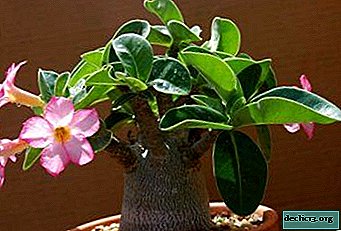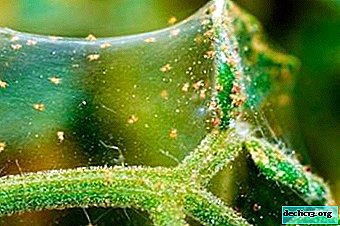Care for croton (codium) at home

Croton (codium) is an interesting indoor plant that designers use when decorating offices and houses. All thanks to the varied color and shape of the leaves. And this plant needs care. Therefore, the topic of the article will be the care at home for croton.
There are types of croton, which in the natural environment grow to a height of three meters. The height of indoor copies does not exceed one meter.
Croton - moody and outwardly demonstrates that you care for him incorrectly. Such signals are reduced to discoloration or wilting of leaves.
Care Secrets
- Temperature mode. The temperature in the room should be above 16 degrees, otherwise the croton discards the leaves. Low temperatures lead to decay of the root system. The optimum temperature of the content is 22 degrees.
- Lighting. With good lighting, the codium leaves become evenly green and acquire a bright color. Do not allow the sun to fall on the flower in summer. In winter, to ensure comfort, keep the south window on the windowsill.
- Watering. During the warm season croton water well and regularly. The soil should dry out no more than a centimeter. Lack of moisture causes a lot of problems. However, one cannot overdo it with watering, otherwise the aerial part of the croton and the root will rot. Reduce watering in autumn and winter. If there is a moisture deficit, as the plant will report saggy leaves, spray from a spray bottle with room temperature water. Using cold water will start the leaf drop procedure.
- Air humidity. In spring and summer, spray the codeium regularly. Perform the procedure in winter, only less often. Wipe the leaves with a damp cloth. To increase the humidity near the pot, place a container with wet pebbles, which, if properly formed, will further decorate the interior.
- Top dressing. During the growing season, croton needs complex fertilizers, which are recommended to be applied weekly after watering. With the onset of the autumn-winter season, fertilize the flower once a month.
- Transfer. Young plants are recommended to be transplanted in the spring once a year. Use a pot that is slightly larger than the previous one during the process. Transplant carefully, trying to maintain an earthen lump. Remember the drainage, which should account for a quarter of the volume of the pot. Adult specimens are transplanted once every several years.
- Breeding. Proper care promotes growth and creates normal conditions for reproduction. Experienced flower growers do this with seeds and cuttings. Since this is an extensive topic, I will consider it separately.
- Disease. In most cases, a croton suffers from a scale insect and a mealybug, but a spider mite often causes inconvenience. If problems arise, wash the plant with soap and water and treat it with a special preparation.
Video Tips and Instructions
Many indoor plants, including dracaena and croton, need careful care. They more than pay back the labor costs of the grower with a beauty that pleases the eye and fills the interior with paints.
Types of Croton
There are 14 types of croton. In indoor floriculture, one species has found application, which has a large number of varieties, forms and varieties.
In nature, the plant in question is a herbaceous perennial with sinewy, leathery and dense foliage. The leaf shape is ovoid, linear or lanceolate. The highlight is not a sinuous inflorescence with small flowers, but foliage.
In home floriculture, housewives grow croton motley and varieties characterized by the color and shape of the leaves. The plant is demanding for care and maintenance conditions, so lazy and impatient people to grow this beauty will not work. If you are not one of those, there will be something to do with croton when bored.
- Croton motley. An evergreen shrub that grows to a meter high at home. The shoots are smooth, and the leaves have a lanceolate shape and a green color. The color scheme of foliage varies depending on the variety.
- Croton motley genuin. Foliage of a lanceolate shape, tapering to the base with solid and even edges. On the vein, which runs in the center of the leaflet, there is a silver pattern.
- Croton motley tortie. It is characterized by olive-green leaves with a red streak and a golden stripe. There are small spots along the strip.
- Croton variegated oval-leaved. On the leaves there is a central vein with a golden color pattern. Oval leaflets with a blunt base and apex.
- Croton motley three-way. Beautiful leaflets, each of which is divided into three separate parts. On the foliage are streaks of golden hue, passing along the main veins.
- Croton motley decorated. The leaves resemble the foliage of an oval-leaf fellow, however they are elongated.
I looked at the six most common types of codium found in home breeding.
Croton propagation
The birthplace of croton is a tropical area of India and Asia, where in the natural environment the height reaches three meters.
It is impossible to grow codium without proper care and attention. Indoor exotic blooms inconspicuously, but variegated and colorful leaves have excellent decorative properties. The color pigment undergoes changes in early autumn, which is due not to the season, but to the age of the foliage.
The first way - seed propagation
The cultivation of croton from seeds is rarely practiced, technology has the right to life. Sow seeds at the end of winter.
- First, treat the seeds with phytohormones. To do this, dip them in the appropriate solution for two to three hours. Next, surfacely pour into a compact container or box, sprinkled with a thin layer of earth.
- After a month, small shoots will appear. Reinforced seedlings dive into separate pots. Provide seedlings with stable temperature and humidity by airing and spraying.
The second way - cuttings
A popular way to propagate croton is by cutting, although rooted shoots are suitable for this purpose.
- To take root, sprinkle it with earth in a pot with a mother's flower. After rooting, cut off a new shoot and plant it in a separate flowerpot.
- The basis of propagation by cuttings is the use of phytohormones. Fifteen centimeters long cuts are immersed in water with activated and charcoal. After the milky juice appears on the slices, dry the cuttings. To reduce the rate of moisture evaporation, roll foliage on the shoots with a straw.
- Plant the finished planting material in a moistened substrate and keep in greenhouse conditions until rooting. The care that accompanies this process is reduced to regular ventilation and spraying.
- After 30 days, the shoots will give roots. After that, plant them. There are growth stimulants on sale that accelerate the rooting process.
For beginners, I do not recommend the second method, but more experienced specialists can try it.
Video Tips for Proper Reproduction
What to do if leaves dry and fall
As practice shows, if a croton discards leaves, it is improperly looked after or pests have appeared. In some cases, this phenomenon is due to a natural process.
In this chapter of the article I will tell you what to do if the leaves of the croton dry and fall. But before fighting this phenomenon, we will determine the root cause.
The leaves of croton have an unusual color, so immediately detecting signs of drying is problematic. Most often, the problem is noticed when the foliage crumbles. Basically, such consequences are caused by a deficiency (leaves are dry and crumble when touched) or excess moisture (leaves are stiff and drawn), dry air, drafts or pests.
A common pest that affects exotic is considered to be a spider mite. It can be determined by loss of color and cobwebs on the foliage. It causes a lot of problems to the plant and scabbard, when waxy dark spots appear on the leaves.
Useful Tips
If a plant sheds old leaves that are located in the bottom row - this is a natural process. If young foliage falls, make sure you care for the flower correctly.
- If there are characteristic signs of pest damage, treat croton with special preparations and cut the affected leaves. To combat the spider mite, I advise you to use Actellik, and Karbofos will help to cope with the scale.
- If no traces of pests are found, change the watering technique. The topsoil should dry out and the bottom should be wet. If the room is hot, spray the codeium regularly with water and wipe the leaves.
Having listened to the recommendations, you will preserve the pristine beauty of the exotic croton. Just remember to establish the reason for the falling sheets before starting the action. Only in this case you will not harm the flower and can help.
Summing up the above, I will add that croton reaches a peak of beauty only in good lighting conditions. If you put the pot in a place where there is not enough light, the leaves will lose their intense color.

















